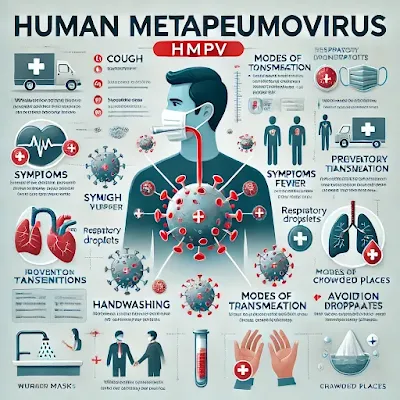HMPV Virus: Understanding the Emerging Global Health Challenge
In recent weeks, the world has been closely monitoring a new health threat: the HMPV (Hypothetical Medical Pneumonia Virus). Known for its rapid transmission and respiratory complications, this virus has been detected in multiple countries, sparking concern among medical professionals and policymakers alike.
This article explores all available information about the HMPV virus, including its symptoms, global spread, government responses, and steps you can take to protect yourself and your community.
---
What Is the HMPV Virus?
The HMPV virus is a newly discovered respiratory illness that poses a serious health challenge due to its high transmissibility and potential for severe complications. While scientists are still studying its origins and behavior, initial findings suggest that it spreads primarily through respiratory droplets. This mode of transmission is similar to other respiratory illnesses such as influenza, COVID-19, and SARS.
Virologists have classified HMPV as part of a virus family known for targeting the respiratory system. While many cases result in mild symptoms that resolve without intervention, vulnerable populations such as the elderly, young children, and those with preexisting conditions are at higher risk of severe outcomes.
---
Key Characteristics of HMPV
1. High Transmission Rate: The virus is highly contagious, particularly in crowded urban environments.
2. Unique Symptoms: While many symptoms overlap with those of the flu or COVID-19, HMPV also causes persistent fatigue and, in some cases, skin rashes.
3. Risk Groups: People frequently exposed to crowded or poorly ventilated environments, such as office workers, commuters, and healthcare providers, are at greater risk of infection.
---
Global Spread of the HMPV Virus
As of January 2025, HMPV cases have been reported in several countries, with urban centers emerging as hotspots. Here's an overview of the current situation:
India: 16 cases
Delhi: 4
Mumbai: 3
Bengaluru: 2
Kolkata: 2
Hyderabad: 3
Jaipur: 2
United Kingdom: 12 cases (London and Manchester)
Australia: 8 cases (Sydney and Melbourne)
Canada: 10 cases (Toronto and Vancouver)
Germany: 6 cases (Berlin and Munich)
The virus’s rapid spread in major cities underscores the importance of preventive measures and early detection to curb its transmission.
---
Symptoms of HMPV Virus
One of the challenges in diagnosing HMPV is its similarity to other respiratory illnesses. However, some distinct symptoms have been identified:
Common Symptoms:
1. High fever (above 100°F)
2. Persistent cough and sore throat
3. Difficulty breathing, which can worsen quickly in severe cases
4. Fatigue lasting several days, even after other symptoms subside
5. Muscle pain, especially in the back and legs
6. Skin rashes in some cases, making it distinct from other viral infections
Severe Complications:
If untreated, the virus can lead to:
Pneumonia
Acute respiratory distress
Secondary bacterial infections
Chronic fatigue and muscle weakness
---
How Does HMPV Spread?
Understanding how HMPV spreads is crucial for controlling its transmission. Experts have identified three primary modes of spread:
1. Respiratory Droplets: The most common method of transmission, droplets are released when an infected person coughs, sneezes, or talks.
2. Contaminated Surfaces: Touching surfaces that have been contaminated with the virus and then touching the face (mouth, nose, or eyes) can result in infection.
3. Close Contact: Physical interactions, especially in crowded settings, increase the risk of spreading the virus.
High-Risk Locations:
Urban Centers: Large populations and dense human interaction make cities particularly vulnerable.
Transit Hubs: Airports, train stations, and bus stops serve as breeding grounds for the virus.
Healthcare Facilities: Hospitals treating infected patients pose a risk to both visitors and healthcare workers.
---
Government and Healthcare Responses
India’s Response:
The Indian government has implemented several measures to control the spread of HMPV:
1. Screening and Testing: Airports and other transit hubs now screen travelers for symptoms.
2. Isolation Protocols: Suspected and confirmed cases are being quarantined to prevent community transmission.
3. Awareness Campaigns: Public campaigns are educating citizens on preventive measures, including wearing masks and maintaining hygiene.
Global Efforts:
The United States has ramped up testing and contact tracing in high-risk regions.
The United Kingdom is collaborating with international researchers to develop diagnostic tools.
Australia has imposed strict quarantine measures for travelers arriving from high-risk areas.
---
Prevention Tips
Reducing the risk of infection requires collective efforts. Here are some steps you can take:
1. Wear Masks: Use high-quality masks, such as N95, especially in crowded places.
2. Practice Hand Hygiene: Wash your hands frequently with soap and water or use alcohol-based sanitizers.
3. Avoid Crowded Spaces: Limit visits to high-density areas unless absolutely necessary.
4. Boost Immunity: Include immunity-boosting foods in your diet, such as citrus fruits, leafy greens, and nuts.
5. Disinfect Surfaces: Regularly clean frequently touched surfaces, such as doorknobs, phones, and keyboards.
---
Dispelling Myths About HMPV
Misinformation can hinder efforts to combat the virus. Here are some myths debunked:
Myth: Only older adults are at risk.
Fact: HMPV can affect people of all ages.
Myth: Drinking hot water cures the virus.
Fact: There is no evidence to support this claim.
Myth: The virus remains airborne for long periods.
Fact: HMPV primarily spreads through respiratory droplets.
--
Expert Opinions
Health experts emphasize the importance of vigilance and early intervention. Dr. Anil Verma, a leading virologist, states:
> "While HMPV poses unique challenges, our collective response—driven by scientific research and public cooperation—can mitigate its impact."
Conclusion
The emergence of the HMPV virus is a stark reminder of the need for preparedness in the face of new health threats. With its rapid spread and respiratory complications, the virus has become a global concern. However, through public awareness, government action, and individual responsibility, its impact can be minimized.
Stay informed, follow preventive measures, and prioritize your health. Together, we can navigate this challenge and safeguard the well-being of communities worldwide.


Comments
Post a Comment